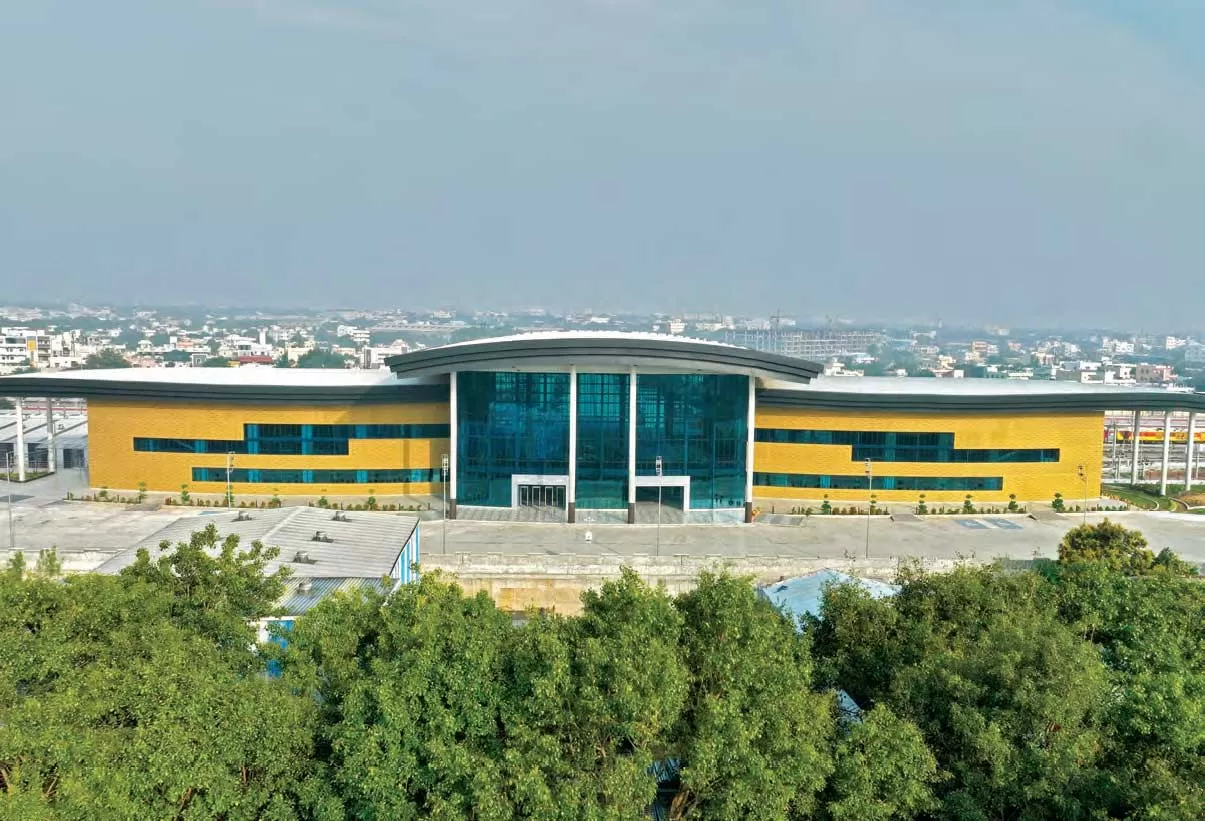Prime Minister Narendra Modi inaugurated the Charlapalli Railway Station in January, built at a cost of ₹ 4.3 billion. Designed as a major terminal in Hyderabad, it aims to decongest the existing Secunderabad and Nampally stations. The station is set to ease travel for nearly 50,000 passengers daily, serving as a halting point for 25 train pairs and facilitating the operation of 50 trains each day.
Pearl concept and connectivity
Discussing the design brief, RoopaKala D S, Principal Architect, RR Architects & Associates, says,
The architectural form of Charlapalli Railway Station is inspired by a shell, beautifully symbolising Hyderabad’s identity as the ‘City of Pearls’. The shell shape was chosen not only for its aesthetic appeal but also for its symbolic connection to the region’s long-standing tradition of pearl trading and craftsmanship. This form influences the station’s layout, optimising smooth circulation and efficient spatial arrangement. The organic flow of the design minimises congestion, allowing passengers to navigate easily through the station.”
The station features nine platforms and 19 tracks with excellent accessibility to public transport. Strategically located in the eastern corridor of Hyderabad, it is seamlessly linked to NH163 and the Outer Ring Road (ORR), facilitating smooth intercity travel while reducing congestion at Secunderabad Railway Station.
Catering to industrial growth
According to a railway official involved in the project, “Charlapalli has a non-polluting industrial estate, primarily comprising electronics and soft industries. These small-scale industries produce various products that can now be transported efficiently via Charlapalli Railway Station. Previously, they had to rely on Secunderabad but with Charlapalli’s proximity – within 3 to 5 km – transportation has become far more convenient. The newly built parcel office has been designed to handle logistics efficiently.
A citizen-centric station
As travellers arrive at Charlapalli Railway Station, a spacious driveway efficiently directs vehicles to designated parking zones. Separate private and public parking areas, along with convenient drop-off points, ensure seamless passenger transitions.
In fact, it is the second air-conditioned railway terminal in South India, following the Sir M Visvesvaraya Terminal in Bengaluru, and is equipped with modern amenities, including lifts, escalators and extensive parking spaces. General waiting areas, dedicated ladies’ waiting areas with feeding zones, toilets and drinking water facilities are easily accessible. The reserved lounge and executive lounge provide premium waiting spaces for reserved passengers.
As passengers approach the station entrance, they step into a double-height central lobby, a spacious and light-filled arrival hall. Booking counters are positioned for easy access, while clear signage intuitively guides travellers towards waiting areas and other amenities inside the station building.
Airport-like amenities
“For passengers with extended layovers, sleeping pods are available, providing a quiet and secure resting space, making Charlapalli Railway Station a modern, passenger-centric railway hub,” mentions RoopaKala. “The station also features two large foot-over bridges for improved access, preventing congestion and ensuring a smooth flow.”
The railway official adds, “People are very pleased as it is one of a kind in the city and is now considered an iconic project. It has been designed with modern concepts that enhance the user experience. The station also offers excellent waiting areas, work-friendly cafeterias and even Airbnb-style overnight accommodations, catering to modern traveller needs. Public movement has been carefully planned to avoid clutter and enhance the overall experience.”
Key challenges
As railway authorities indicate, while the station building itself was completed in nine months, infrastructure development involved multiple stages. While some activities could be carried out in parallel, certain constructions had to be completed sequentially.
Highlighting specific challenges, RoopaKala explains, “The limited space for designing the building was a significant challenge. This was addressed by minimising the width and maximising the length of the building, aligning it parallel to the tracks to meet functional requirements.”
Another major challenge was environmental restoration. During construction, some greenery was affected. Thus, extensive replanting and urban forestry measures were undertaken. Large trees were even translocated to nearby railway stations and training schools, achieving a 90 per cent survival rate.
Sustainability is key
The station features a smart, interactive façade designed to be both functional and responsive. It incorporates perforated metal panels that allow for controlled daylight while reducing heat gain, ensuring thermal comfort inside the station. The façade is integrated with smart digital display lighting systems. At night, it transforms with lighting elements, enhancing visibility while maintaining a festive aesthetic. The lighting can also be customised for different events, making it visually engaging while balancing practicality with a contemporary identity suited for a modern transit hub.
The central lobby is designed to maximise natural light and ventilation while minimising heat gain. Shading elements, such as perforated panels on the sides of the building and an extended canopy, reduce direct sun exposure, keeping the space cool. A significant number of trees have been planted throughout the station, creating a microclimate.
Further, a sewage treatment plant (STP) has been implemented, with all drainage outlets – including water used for cleaning platforms and premises – connected to the STP. Residual water from cleaning operations is collected, treated and reused for washing coaches and landscape irrigation. Additionally, the station is equipped with rainwater harvesting systems, further enhancing its sustainability by collecting and reusing rainwater. Solar panels integrated into the platform shelters help cut electricity costs and reduce the station’s carbon footprint.
Fact file
Built-up area: 6,300 sq m
Cost: Rs 4.3 billion
Structural consultant and MEP contractor: Buildtech Engineering Consultants
Lighting consultant: Signifty by Philips, Arkah Enterprises
Architectural interior and exterior solutions: Shah Decors
Façade consultant: Hunter Douglas India
HVAC contractor: Trac Fujico AIR Systems
Escalator & elevator supplier: Johnson Lifts
Electrical contractor: Sri Sai Leela Electrical Projects
Structural façade services: Ramesh Krishna
ACP and structural glazing contractor: V Radhakrishna and Associates.
Civil Contractor- Teja Construction





















